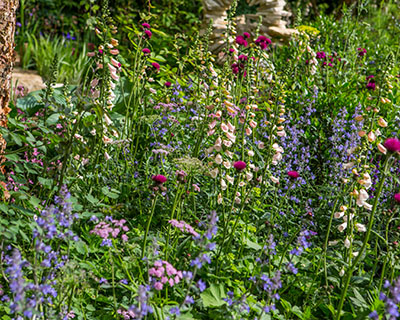Ten great native plants to see at RHS Chelsea
Designers are going wild for native plants at this year’s show. Here are ten brilliant species you can see at the show and grow at home
There’s a growing trend in the world of horticultural design to support wildlife and create a more naturalistic look in gardens.
That’s not to say there isn’t a place in our gardens for exotic non-native species or cultivars, but if you're looking to increase the wildlife that visits your green space, then there are worse places to start than with native plants.
So without further ado, here is a list of native plants, compiled by Helen Bostock, our Senior Wildlife Specialist, which will provide food for all manner of fauna and interest for you in the garden. It includes a lovely spread of shrubs, climbers, herbaceous
Grow as a medium-sized tree to maximise flowering for bees and leaf area for moths such as the Barred Sallow.
Find it at RHS Chelsea in:A useful early nectar plant, watch for the fluffy bee-fly pushing its long ‘snout’ into the flowers.
Find it at RHS Chelsea in:
Along with the yellow summer-flowering lady’s bedstraw (Galium verum), sweet woodruff (Galium odoratum) may play host to the caterpillars of the stunning elephant hawkmoth.
Find it at RHS Chelsea in:
- The Meta Garden: Growing the Future
- The MEDITE SMARTPLY Garden
- Morris & Co.
- St Mungo’s Putting Down Roots Garden
Bumblebees will thank you for introducing this plant as they fight for the flowers with late spring and early summer butterflies.
Find it at RHS Chelsea in:
Attractive to both butterflies and moths, red campion can bear a second flower flush if cut down after the first.
Find it at RHS Chelsea in:
Find this and other varieties of foxglove at RHS Chelsea in:
- Connected, by EXANTE
- The Meta Garden: Growing the Future
- The Perennial Garden ‘With Love’
- A Textile Garden for Fashion Revolution
- Morris & Co.
The flat disc of flowers make it an easy landing pad for a whole myriad of beetles, hoverflies, sawflies, and the smaller solitary bees and wasps.
Find this at RHS Chelsea in:
Grow this for the bees and butterflies, remembering to leave the seeds for sparrows and finches to find.
Find this at RHS Chelsea in:
- The Meta Garden: Growing the Future
- A Rewilding Britain Landscape Garden
- St Mungo’s Putting Down Roots Garden
The tangle of climbing stems make it a good nesting spot for birds who also enjoy the berries. Tubular flowers demand the long tongues of butterflies, moths and some bumblebees to access the nectar.
Find this at RHS Chelsea in:
Hoverflies will visit the flowers but it’s the juicy berries which draw the greatest attention from hungry garden birds and small mammals.
Find it at RHS Chelsea in:
Of course a list of ten native plants can never be exhaustive and there are plenty more to choose from that might not feature at RHS Chelsea in May.
That includes the likes of garlic mustard (Alliaria petiolata) which is an excellent source of caterpillar food for the orange tip butterfly but can seed itself around; Yarrow (Achillea millefolium), which featured prominently at RHS Chelsea 2021, which often pops up in lawns if left unmown and is good for short-tongued insects; bird’s foot trefoil (Lotus corniculatus) has good flowers for bumblebees and provides food for the caterpillar of the common blue butterfly; and of course ivy which is a fantastic source of nectar and pollen later in the year, if allowed to mature and flower.
